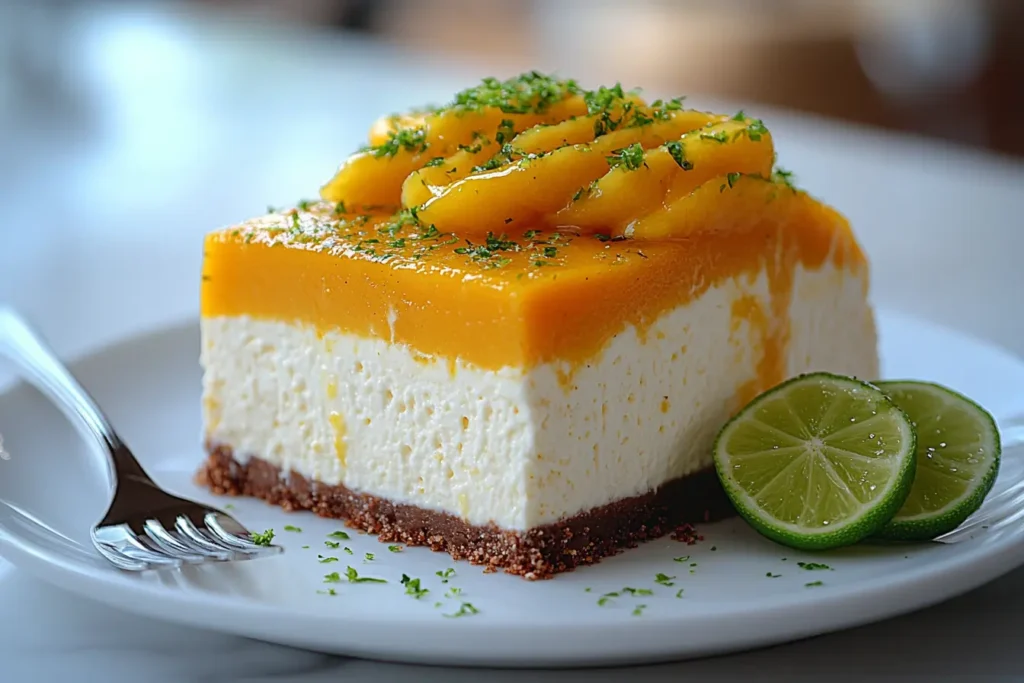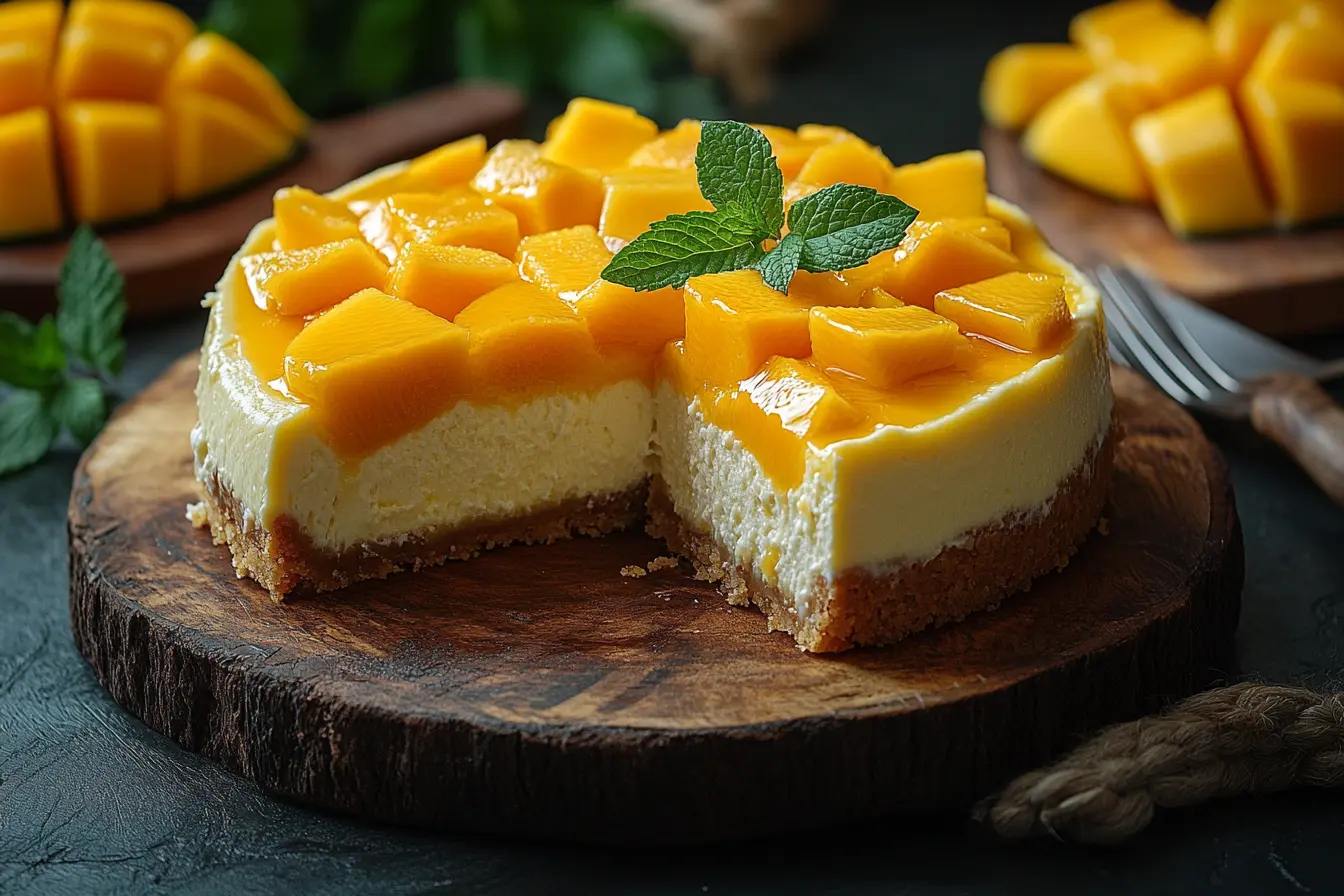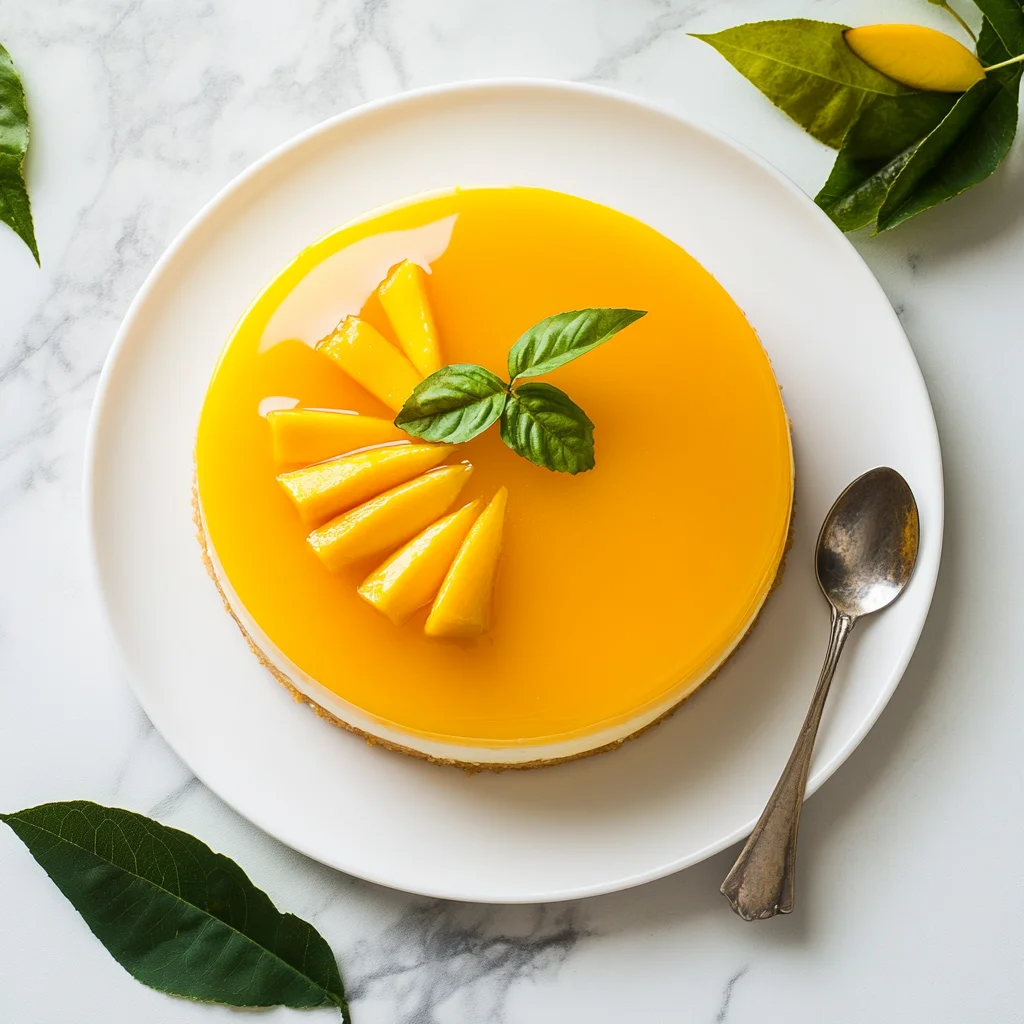I. Introduction
Mango cheesecake—just saying the words out loud is enough to make your mouth water, right? There’s something truly magical about the combination of tropical mango flavor and the rich, creamy texture of cheesecake. Whether you’re looking to impress guests at a summer gathering or simply want to treat yourself to a delightful dessert, mango cheesecake ticks all the boxes.
Personally, I’ve always had a soft spot for this dessert. It’s not just because mangoes remind me of warm, sunny days spent with family, but also because the cheesecake’s luxurious texture paired with the bright, tangy mango creates a perfect balance. If you’re like me, always on the lookout for desserts that feel like a little slice of heaven, then you’re in the right place.
This guide is designed to give you a deep dive into the ingredients that make mango cheesecake so special. From the buttery graham cracker crust to the creamy filling and the luscious mango topping, we’ll explore each component in detail, ensuring you have all the knowledge you need to create this dessert masterpiece at home.
II. What is Mango Cheesecake Made Of?
So, what exactly is mango cheesecake made of? At its core, mango cheesecake consists of three main components: the crust, the filling, and the topping. Each part plays a crucial role in creating the final dessert, and using high-quality ingredients is key to achieving that perfect flavor and texture.
For the crust, we typically use a graham cracker base, which provides a crunchy contrast to the smooth filling. Speaking of the filling, this is where the magic happens—a blend of full-fat cream cheese, sugar, and mango puree creates a creamy, tangy layer that’s hard to resist. Finally, the topping often includes a mango compote or jelly, adding a burst of fruity flavor that ties everything together. Using the freshest mangoes, whether fresh or frozen, can make a big difference in the taste. Trust me, your taste buds will thank you!
III. The Crust: The Foundation of Mango Cheesecake
The crust is the unsung hero of any cheesecake, and mango cheesecake is no exception. It’s the crunchy, buttery layer that provides the perfect foundation for the creamy filling above it. The classic choice for the crust is a graham cracker base, but there are a few variations you can explore depending on your dietary preferences or flavor inclinations.
Graham Cracker Crust: The graham cracker crust is a timeless favorite because of its simplicity and flavor. To make this crust, you’ll need graham crackers, sugar, and melted butter. The key is to crush the graham crackers into fine crumbs, mix them with the sugar and melted butter, and then press the mixture firmly into the bottom of your springform pan. This will ensure the crust is compact and can hold the filling without crumbling. For an extra touch of flavor, you could also add a pinch of cinnamon or nutmeg to the crust mixture.
Alternative Crust Options: If you’re looking for a gluten-free option, simply swap out the graham crackers for gluten-free cookies or graham crackers. For a nutty twist, you could use ground almonds or pecans as the base, which adds an extra layer of richness and complements the tropical flavor of the mango.
Cheesecake Base Preparation: Once your crust mixture is ready, press it into the bottom of the pan using the back of a spoon or the bottom of a glass to create an even layer. It’s important to press firmly to avoid any gaps, which could lead to a crumbly base. After pressing the crust, chill it in the fridge for about 30 minutes to help it set. This step is crucial, especially if you’re making a no-bake mango cheesecake, as it ensures the crust will hold up when you pour the filling over it.
IV. The Creamy Filling: The Heart of Mango Cheesecake
Now let’s talk about the filling—the heart and soul of any cheesecake. The filling is where the rich, creamy texture comes from, and it’s what gives the dessert its distinctive flavor. For mango cheesecake, the filling is a harmonious blend of cream cheese, mango puree, sugar, and a few other essential ingredients that work together to create a luscious, indulgent layer.
Core Ingredients: Cream Cheese, Mango Puree, and Sugar
The main components of the filling are full-fat cream cheese, mango puree, and sugar. Full-fat cream cheese is non-negotiable here—it’s what gives the cheesecake its silky smooth texture. The mango puree adds that signature tropical sweetness, while the sugar balances everything out. If you’re wondering about the mango puree, you can easily make it at home by blending ripe mangoes until smooth. Both fresh and frozen mangoes work well, so choose whichever is more convenient for you.
Cream Cheese in Desserts: The Key to Richness
Cream cheese is a staple in many dessert recipes because of its ability to add creaminess and richness. In a cheesecake, it’s particularly important because it helps create that dense, yet airy texture that we all love. When preparing the filling, make sure your cream cheese is at room temperature—this makes it easier to mix and helps avoid lumps.
Mango Puree for Cheesecake: Fresh vs. Frozen Mangoes
Mango puree is the star ingredient in this filling, providing both flavor and color. If you’re using fresh mangoes, opt for varieties like Ataulfo or Haden, known for their sweetness and minimal fibrous texture. If using frozen mangoes, let them thaw completely and drain any excess liquid before blending. The puree should be smooth and thick, with no chunks, to ensure a consistent filling.
Lime Juice in Cheesecake: Balancing Sweetness
Lime juice is a secret weapon in this recipe. It adds a subtle acidity that enhances the mango’s sweetness and balances the richness of the cream cheese. Just a tablespoon or two is enough to brighten up the filling without overpowering the mango flavor.
Creating the Creamy Mango Filling
To make the filling, start by beating the cream cheese and sugar together until smooth. Then, add the mango puree and lime juice, continuing to mix until everything is fully incorporated. The mixture should be velvety and free of any lumps. If you’re making a no-bake version, this is where you’d add the gelatin, which helps the cheesecake set properly without baking.
Gelatin for Setting Cheesecake: A No-Bake Essential
Gelatin is essential for a no-bake mango cheesecake. It’s what allows the filling to firm up and hold its shape once chilled. To use gelatin, you’ll first need to bloom it—this means sprinkling the gelatin over cold water and letting it sit for a few minutes until it swells. Then, gently heat the mixture until the gelatin dissolves completely before mixing it into the cheesecake filling. If you prefer a vegetarian option, agar-agar works as a great substitute for gelatin.
V. The Topping: Adding a Finishing Touch
The topping is the final layer of your mango cheesecake, and it’s where you can really get creative. Whether you prefer a simple mango jelly, a sweet mango compote, or fresh mango slices, the topping not only adds flavor but also elevates the visual appeal of the dessert.
Mango Cheesecake Topping: One of the most popular options is a mango jelly topping. To make this, you’ll need mango puree, lime juice, sugar, and gelatin. Mix the ingredients together and pour the mixture over the chilled cheesecake. The jelly will set into a beautiful, glossy layer that’s bursting with mango flavor.
Sweet Mango Compote: If you prefer a more textured topping, a mango compote is a great choice. To make it, cook diced mangoes with sugar and a bit of lime juice until the fruit breaks down and thickens slightly. This compote can be spooned over the cheesecake just before serving, adding a fresh and fruity contrast to the creamy filling.
Incorporating Citrus: For an extra zing, you can add lime zest or juice to your topping. The citrus pairs beautifully with the mango, cutting through the sweetness and adding a refreshing note to the dessert. If you’re feeling adventurous, you could even mix in some passion fruit pulp for a tropical twist.
Layered Cheesecake: Another option is to create a layered cheesecake by adding a thin layer of mango puree or jelly between the filling and the topping. This adds depth of flavor and a striking visual element to each slice.
VI. How to Make Mango Cheesecake: Step-by-Step Instructions
Ready to make your own mango cheesecake? Let’s walk through the process step by step. This method will ensure that your cheesecake turns out perfect every time, whether you’re a seasoned baker or a beginner.
Preparation of the Crust: Start by preparing the graham cracker crust as described earlier. After pressing the crust into the pan, let it chill in the fridge while you make the filling. This step is crucial for setting the base and ensuring it doesn’t crumble when you add the filling.
Making the Cheesecake Filling: In a large mixing bowl, beat the cream cheese and sugar together until smooth. Add the mango puree and lime juice, and continue to beat until the mixture is completely smooth and lump-free. If you’re making a no-bake version, gently fold in the dissolved gelatin at this stage.
Chilling Time for Cheesecake: Pour the filling over the chilled crust and smooth the top with a spatula. The cheesecake needs to be chilled for at least 4 hours, but overnight is best. This allows the flavors to meld together and the filling to set properly. Trust me, the wait is worth it!
Assembly and Chilling Instructions: Once the filling has set, you can add your chosen topping. Whether it’s a mango jelly, compote, or fresh fruit slices, spread it evenly over the top of the cheesecake. After adding the topping, chill the cheesecake for an additional hour to let the flavors meld together.
Pro Tips for Success: To avoid cracks in your cheesecake, make sure all your ingredients are at room temperature before mixing. Also, avoid overmixing the filling, as this can incorporate too much air and lead to a grainy texture. Finally, when adding the topping, pour it gently to prevent disturbing the smooth surface of the filling.
VII. Mango Cheesecake Variations
The beauty of mango cheesecake lies in its versatility. Here are some variations you can try to put your own spin on this classic dessert.

No-Bake Mango Cheesecake: If you’re short on time or want to skip the oven, a no-bake mango cheesecake is the way to go. Simply prepare the crust and filling as described, but instead of baking, let it chill in the fridge for a few hours. The gelatin will help the filling set without needing heat.
Mango Lime Cheesecake: For a tangy twist, add extra lime juice and zest to the filling. The lime’s acidity cuts through the richness of the cream cheese, making the cheesecake feel lighter and more refreshing—a perfect dessert for hot summer days.
Vegan Mango Cheesecake: Want to keep things dairy-free? Use dairy-free cream cheese and a plant-based gelatin substitute like agar-agar. The result is a rich and creamy vegan mango cheesecake that’s just as delicious as the original.
Gluten-Free Mango Cheesecake: If you’re gluten-sensitive, simply swap out the graham crackers for a gluten-free alternative. Many stores carry gluten-free graham crackers or cookies, which work perfectly in this recipe.
VIII. Frequently Asked Questions
Here are some common questions about making mango cheesecake, along with some helpful answers to ensure your dessert turns out perfectly.
What type of mango is best for cheesecake? The best mango varieties for cheesecake are Ataulfo and Haden, known for their sweet flavor and smooth texture. These mangoes blend well into a creamy puree without any fibrous bits.
Can I use frozen mangoes? Absolutely! Frozen mangoes are a great option, especially if fresh mangoes aren’t in season. Just make sure to thaw them completely and drain any excess liquid before blending into a puree.
How long does mango cheesecake last? Mango cheesecake can be stored in the refrigerator for up to 5 days. Make sure to cover it with plastic wrap or store it in an airtight container to keep it fresh.
Can I freeze mango cheesecake? Yes, you can freeze mango cheesecake for up to 3 months. Just be sure to wrap it tightly in plastic wrap and aluminum foil to prevent freezer burn. To serve, let it thaw in the fridge overnight.
What if I don’t have gelatin? If you don’t have gelatin, you can use agar-agar as a vegetarian substitute. Just be sure to follow the package instructions for the correct amount and preparation.
IX. Pro Tips for Perfecting Mango Cheesecake
Want to take your mango cheesecake to the next level? Here are some expert tips to help you achieve the perfect texture and flavor.
Using Full-Fat Cream Cheese: Full-fat cream cheese is essential for a rich and creamy texture. Low-fat versions may result in a runnier filling that doesn’t set as well.
Achieving the Perfect Texture: To avoid cracks in your cheesecake, make sure not to overmix the filling, and chill it thoroughly before adding the topping. If you’re baking the cheesecake, bake it in a water bath to maintain even heat distribution.
Balancing Flavors: Mango is naturally sweet, so adding a bit of lime juice helps balance the flavors. Taste the filling before setting it to ensure the sweetness and acidity are to your liking.
Tips for Perfecting Your Cheesecake: For more detailed tips on making the perfect cheesecake, check out these Tips for perfecting your cheesecake.
X. Mango Cheesecake Serving Suggestions
When it comes to serving your mango cheesecake, presentation is key. Here are some ideas to make your dessert look as good as it tastes.
Serving with Fresh Fruit: Enhance the tropical theme by serving your cheesecake with fresh fruits like kiwi, passion fruit, or even berries. The bright colors and flavors will complement the mango beautifully.
Garnishing Ideas: A dollop of whipped cream, a sprinkle of lime zest, or a few mint leaves can add the finishing touches to your cheesecake. These simple garnishes not only look great but also add an extra layer of flavor.
Best Occasions to Serve Mango Cheesecake: Mango cheesecake is a versatile dessert that’s perfect for any occasion. Serve it at summer barbecues, Mother’s Day brunches, or as a show-stopping end to a dinner party.
XI. Related Recipes and Inspirations
If you’re a fan of mango cheesecake, here are some related recipes and inspirations that you might enjoy trying.
Mango Cheesecake No-Bake Recipe: Looking for an easy, no-bake version? Check out our Mango Cheesecake No-Bake Recipe for a simple and delicious alternative.
Easy Gluten-Free Dessert Recipes: If you’re interested in gluten-free desserts, explore our Gluten-Free Dessert Recipes for more inspiration.
Strawberry Cheesecake Ice Cream Recipe: Craving something different? Try our Strawberry Cheesecake Ice Cream Recipe for a cool and creamy twist on traditional cheesecake.
XII. Conclusion
Mango cheesecake is more than just a dessert—it’s an experience. From the rich and creamy filling to the tropical mango flavor, every bite is a celebration of summer. Whether you’re a seasoned baker or just starting out, this guide gives you everything you need to create a mango cheesecake that’s sure to impress.
So why not give it a try? I’d love to hear how your mango cheesecake turns out! Don’t forget to share your results and tag Kai Recipes on social media. And if you’re looking for more mango-inspired desserts, be sure to Explore more mango dessert recipes.
XIII. FAQs Section
How long does it take to make mango cheesecake? Including chilling time, it typically takes about 6-8 hours, with most of that being chilling time.
Can I make mango cheesecake ahead of time? Yes, mango cheesecake can be made a day or two ahead of time, which makes it perfect for entertaining.
What are some other toppings I can use for mango cheesecake? You can use a variety of toppings, such as passion fruit jelly, berry compote, or even a drizzle of chocolate.
Is there a way to make mango cheesecake less sweet? If you prefer a less sweet cheesecake, reduce the amount of sugar in the filling, and use a more tart topping like lime jelly.
What’s the best way to cut and serve mango cheesecake? Use a sharp knife dipped in hot water to make clean cuts. Wipe the knife between each cut for neat slices.

